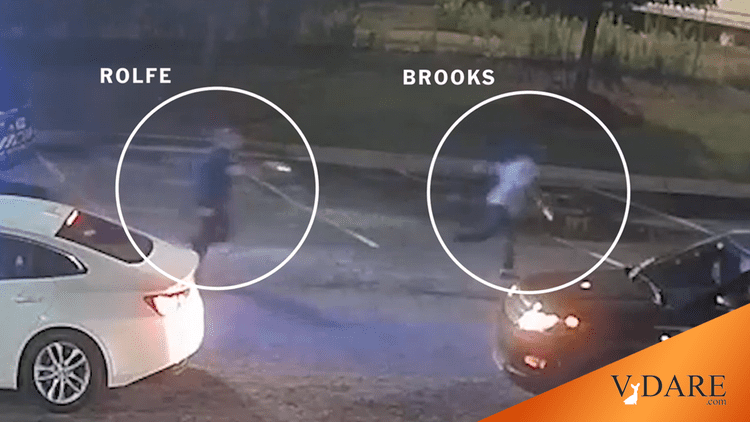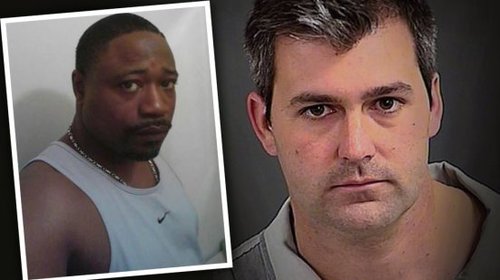In the Atlanta case where a man too drunk to drive resisted arrest, attacked cops, and got shot (leading to more riots, and the burning of a Wendy's) one of the complaints is that the late Rayshard Brooks was "shot in the back" as he was trying to flee.
11:23 p.m. The two officers have been at the scene for 27 minutes. When the breath test is complete, Officer Rolfe tells Mr. Brooks he “has had too much drink to be driving,” and begins to handcuff him. Less than a minute later, Mr. Brooks is shot.
Police footage and video filmed by a witness, Tiachelle Brown, shows Mr. Brooks grappling with the officers on the ground. Officer Rolfe says, “Stop that. Stop fighting, stop fighting,” and Officer Brosnan shouts, “You’re going to get Tased.”
Mr. Brooks says “Mr. Rolfe, come on man. Mr. Rolfe.” He seizes a Taser from Officer Brosnan, stands up and punches Officer Rolfe. Officer Rolfe fires his Taser gun. The darts hit Mr. Brooks, and Officer Rolfe continues trying to stun him.
Mr. Brooks runs away, holding Officer Brosnan’s Taser gun. Officer Rolfe gives chase, and continues to try to stun Mr. Brooks.
The security camera footage filmed at Wendy’s shows Officer Rolfe chasing Mr. Brooks. In seconds, Officer Rolfe passes his Taser from his right hand to his left hand, and reaches for his handgun.
While being chased, and in full stride, Mr. Brooks looks behind him, points the Taser he is holding in Officer Rolfe’s direction, and fires it. The flash of the Taser suggests that Mr. Brooks did not fire it with any real accuracy.
Officer Rolfe discards the Taser he is carrying, draws his handgun and fires it three times at Mr. Brooks as he is running away. Mr. Brooks falls to the ground.
How Rayshard Brooks Was Fatally Shot by the Atlanta Police, by Malachy Browne, Christina Kelso and Barbara Marcolini, NYT, June 14, 2020
![]() This is the same thing that we saw in the Michael Slager / Walter Scott case, where the black suspect also tried to grab the officer's Taser, and where the white officer was sent to jail for shooting him as he was fleeing. (A 1985 case called Tennessee v. Garner held that an officer couldn't use deadly force against "an apparently unarmed, nondangerous fleeing suspect; such force may not be used unless necessary to prevent the escape and the officer has probable cause to believe that the suspect poses a significant threat of death or serious physical injury to the officer or others.")
This is the same thing that we saw in the Michael Slager / Walter Scott case, where the black suspect also tried to grab the officer's Taser, and where the white officer was sent to jail for shooting him as he was fleeing. (A 1985 case called Tennessee v. Garner held that an officer couldn't use deadly force against "an apparently unarmed, nondangerous fleeing suspect; such force may not be used unless necessary to prevent the escape and the officer has probable cause to believe that the suspect poses a significant threat of death or serious physical injury to the officer or others.")
A law enforcement professional explained here that this doesn't apply once the arrestee is in custody.
But once the arrest decision is made and the officer makes physical contact with Scott, a seizure has occurred. The fact a seizure has legally occurred, once the officer tells Scott he is under arrest and makes physical contact, changes the entire nature of the shooting.
The officer is not shooting a fleeing felon and the shooting is not a Garner seizure. The seizure occurred already, and Scott is actually escaping from custody, which makes him a shoot-on-sight subject. Persons escaping from custody can be shot.
We do not know exactly what happened with the Taser. But we do know this much, Scott resisted arrest at least three times. Twice he fought with the officer and then he ran from the officer. We know the officer attempted to use less-than-lethal force, first by attempting muscling techniques at least on two occasions and then escalated to a Taser and only used the firearm after Scott fought with him, disarmed him and was escaping custody.
Of course, once he's attacked, physically, two armed policemen, and grabbed what is referred to as a "less-lethal" (not non-lethal) weapon, then the "fleeing felon" thing is less important, in my view. At that point the police are trying to protect themselves and the public.




 This is the same thing that we saw in the
This is the same thing that we saw in the 








